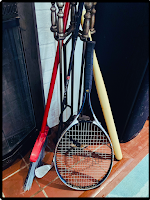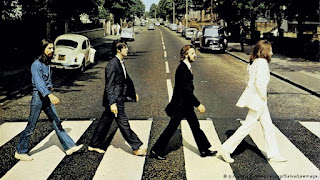My Life As an Air-Guitarist - Chapter 2: Finding Your Prop
Need to catch up? Find the preceding chapters here.
Now, a tennis racquet can be hard to come by for an aspiring air-guitarist unless there's a tennis player in the house. And anyone serious about tennis is likely unwilling to let their Prince racquet double as a Les Paul. Fortunately, that was not the case for me in our house back in '76. We just happened to have tennis racquets with no serious player in the family. The 70s were weird like that.
If you don't have a racquet around the house or your Johnny McEnroe brother is too stiff to let you borrow his, there's a multitude of other common items found around the home you can use to practice your chops, including:
Broom - I know I shared my feelings previously, but I'll give the broom an official endorsement here. The broom is a common go-to. Most homes have one, and besides the lack of support on the bristle end and the excess handle, it's a good entry-level piece. Plus, if someone walks in on you air-guitaring, you can quickly pretend you were just sweeping the floor.
Whiffle Ball Bat - These are a great choice. They're inexpensive, lightweight, common in any household with young kids, and have a solid form that's easy to keep close to the hip. The textured handle also offers a plausible boundary between the neck and body of a guitar, so you don't end up climbing too high on something like "Eruption." Believability is a key trait of a true air-guitarist. These can also be customized with colored duct tape as another way to showcase your artistry and persona. Plus, if someone walks in on you air-guitaring, you can quickly pretend you were just practicing your swing.
Golf Club - Similar to the tennis racquet, this requires a golfer in the home. Golfers themselves don't tend to be air-guitarists. For one, no one who wants to be an above-average golfer can afford time off the course and waste it learning how to air-guitar. Plus, air-guitaring on a golf course with a club is frowned upon, which I learned firsthand. Golfers do not like distractions on the course. My brother-in-law Rich is the one exception I know to the air guitar/golf rule. He's a very good golfer and a very good air-guitarist. You should check him out sometime. But if you tried golf, realize you suck and enjoy air-guitaring, hold on to your clubs. They might come in handy. Plus, if someone walks in on you air-guitaring, you can quickly pretend you were just practicing your swing.
Plunger - In a pinch. However, it's not recommended you handle the "plunge" end with bare hands. Plus, with the rounded head, it tends to roll off the body and is hard to command. A plunger is reserved for advanced air-guitarists only who have the swagger to pull off air-guitaring with a plunger, so much so that no one would think it odd they were air-guitaring with a plunger because the air-guitaring would be that awesome. But, if you're using it as a last resort, and someone walks in on you air-guitaring with a plunger, it's the least likely thing anyone would ever expect you to use for an air-guitar. So you can often get away with pretending you were about to plunge a clog, even if you're not in the bathroom staring down a clogged toilet.
Fireplace Tools - Like the plunger, kind of a last resort as they tend to be covered in soot and ash and can make a mess. But they are usually within reach if you're jamming in the living room, and with a poker, brush, and shovel in the stand, you have many options. Typically, a person who thinks reaching for a fireplace tool during an air-guitar solo is a good idea is usually under the influence of alcohol. However, if someone walks in during a sobering moment and catches you air-guitaring, you can quickly pretend you were rearranging the fireplace tools.
Vehicle Steering Wheel - Reserved for licensed drivers only, the steering wheel can be a worthy instrument in traffic or on long drives. The 10 and 2 hand positions on the wheel are perfect for some general chord strumming, like Pink Floyd's "Another Brick in the Wall Part 2." But if you need to switch it up for something like the solo during "Comfortably Numb," you can close the gap and bring your hands to the 12 and 1 positions, left hand grabbing the wheel from underneath and the right hand on top, and rip off a nice solo on an abbreviated neck. The hand spacing is confined to a tight fretboard, but it's a great opportunity to work on your fingering. I recommend limiting air-guitaring on the steering wheel to experienced drivers and experienced air-guitarists only. While I'm sure air-guitaring while driving has caused significantly fewer accidents than texting and driving, the potential for distraction is there if you're not careful. Also, if you're caught air-guitaring on the steering wheel, it's difficult to pretend you were doing anything else other than air-guitaring on the steering wheel, so confidence is critical.
But if we're having a serious conversation about air-guitar —and I think at this point we are — we must agree that a legitimate technique never involves a prop and is simply pulled off with one's two hands and the air that surrounds them. That's where the real art and magic appear. The ability to stay within oneself and not go "out of bounds" to retain the realistic approach of guitar playing, guided by nothing more than the music emanating from the speakers and the oxygen that fills the room, is a true craft. Think of the difference between a good mime and a shitty one. A true air-guitarist flies without a net.
And when it comes to the real deal, I have two styles. Each lends itself nicely to a believable portrayal of accomplished guitar playing, and I use them interchangeably, employing each based on song selection. And they are what I call:
Finger to Thumb - This is reserved for incredibly "note-y" solos without much in terms of effects or distortion. It's used mostly on songs with a cleaner sound. The thumb on my left hand acts as the fretboard on the neck, while I use my four other fingers to hit the notes, pressing against my thumb on cue. I wouldn't describe it as a natural style but it works on the few occasions I rely on it.
Fingers to Palm - This is a more traditional style and I opt for this variation when I need to use the lower palm of my hand as the fretboard, as that part of the hand would naturally rest against the back of the neck if I were actually playing guitar. My index finger stays in almost constant contact with my thumb to provide some stability and guidance, while the rest of my fingers do most of the leg work. It covers about 70% of my air-guitaring and is perfect for more complicated solos that require lots of intricate fingerwork and heavy effects as well as arena-rock style power chords. I can cover much more ground with this technique than the thumb-to-finger method.
If you expect to be great at anything, you must vary your approach based on the situation. The only people who will disagree with me are those treading water in mediocrity.




Comments
Post a Comment